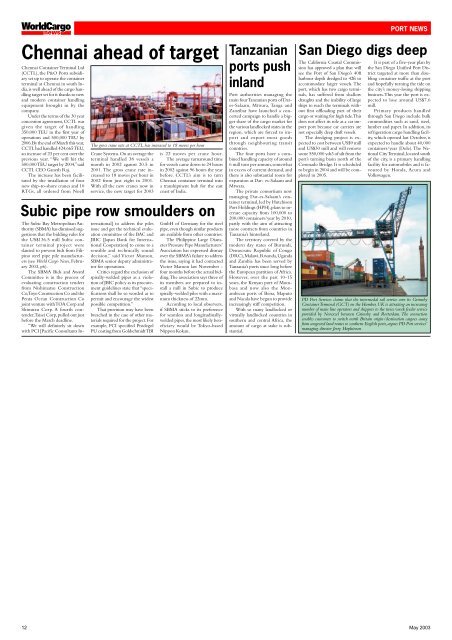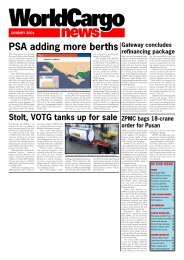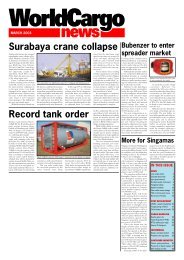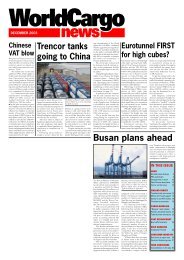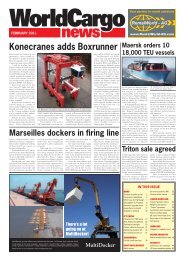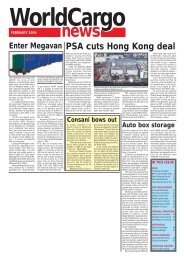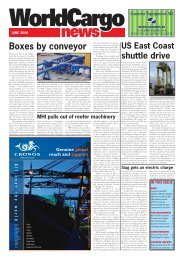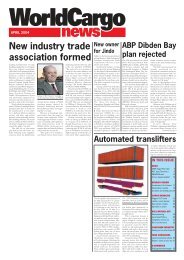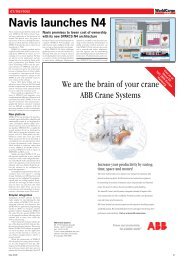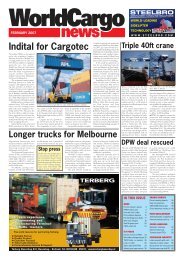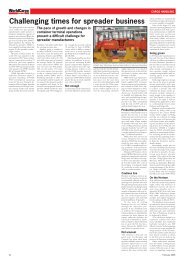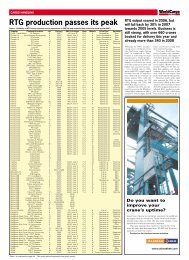Front Cover May - WorldCargo News Online
Front Cover May - WorldCargo News Online
Front Cover May - WorldCargo News Online
Create successful ePaper yourself
Turn your PDF publications into a flip-book with our unique Google optimized e-Paper software.
<strong>WorldCargo</strong><br />
news<br />
Chennai ahead of target<br />
Chennai Container Terminal Ltd<br />
(CCTL), the P&O Ports subsidiary<br />
set up to operate the container<br />
terminal at Chennai in south India,<br />
is well ahead of the cargo handling<br />
target set for it thanks to new<br />
and modern container handling<br />
equipment brought in by the<br />
company.<br />
Under the terms of the 30 year<br />
concession agreement, CCTL was<br />
given the target of handling<br />
350,000 TEU in the first year of<br />
operations and 500,000 TEU by<br />
2006. By the end of March this year,<br />
CCTL had handled 424,665 TEU,<br />
an increase of 23 per cent over the<br />
previous year. “We will hit the<br />
500,000 TEU target by 2004,” said<br />
CCTL CEO Ganesh Raj.<br />
The increase has been facilitated<br />
by the installation of four<br />
new ship-to-shore cranes and 10<br />
RTGs, all ordered from Noell<br />
The gross crane rate at CCTL has increased to 18 moves per hour<br />
Crane Systems. On an average the<br />
terminal handled 38 vessels a<br />
month in 2002 against 20.5 in<br />
2001. The gross crane rate increased<br />
to 18 moves per hour in<br />
2002 from just eight in 2001.<br />
With all the new cranes now in<br />
service, the new target for 2003<br />
is 22 moves per crane hour.<br />
The average turnaround time<br />
for vessels came down to 24 hours<br />
in 2002 against 96 hours the year<br />
before. CCTL’s aim is to turn<br />
Chennai container terminal into<br />
a transhipment hub for the east<br />
coast of India.<br />
Subic pipe row smoulders on<br />
The Subic Bay Metropolitan Authority<br />
(SBMA) has dismissed suggestions<br />
that the bidding rules for<br />
the US$136.5 mill Subic container<br />
terminal project were<br />
slanted to prevent bids from Filipino<br />
steel pipe pile manufacturers<br />
(see World Cargo <strong>News</strong>, February<br />
2003, p6).<br />
The SBMA Bids and Award<br />
Committee is in the process of<br />
evaluating construction tenders<br />
from Nishimatsu Construction<br />
Co, Toyo Construction Co and the<br />
Penta Ocean Construction Co<br />
joint venture with TOA Corp and<br />
Shimuzu Corp. A fourth contender,<br />
Taisei Corp, pulled out just<br />
before the March deadline.<br />
“We will definitely sit down<br />
with PCI [Pacific Consultants International]<br />
to address the piles<br />
issue and get the technical evaluation<br />
committee of the BAC and<br />
JBIC [Japan Bank for International<br />
Cooperation] to come to a<br />
sensible and technically sound<br />
decision,” said Victor Mamon,<br />
SBMA senior deputy administrator<br />
for operations.<br />
Critics regard the exclusion of<br />
spirally-welded pipes as a violation<br />
of JBIC policy as its procurement<br />
guidelines state that “specifications<br />
shall be so worded as to<br />
permit and encourage the widest<br />
possible competition.”<br />
That provision may have been<br />
breached in the case of other materials<br />
required for the project. For<br />
example, PCI specified Prodegol<br />
PU coating from Goldschmidt TBI<br />
GmbH of Germany for the steel<br />
pipe, even though similar products<br />
are available from other countries.<br />
The Philippine Large Diameter<br />
Pressure Pipe Manufacturers’<br />
Association has expressed dismay<br />
over the SBMA’s failure to address<br />
the issue, saying it had contacted<br />
Victor Mamon last November -<br />
four months before the actual bidding.<br />
The association says three of<br />
its members are prepared to install<br />
a mill in Subic to produce<br />
spirally-welded piles with a maximum<br />
thickness of 22mm.<br />
According to local observers,<br />
if SBMA sticks to its preference<br />
for seamless and longitudinallywelded<br />
pipes, the most likely beneficiary<br />
would be Tokyo-based<br />
Nippon Kokan.<br />
Tanzanian<br />
ports push<br />
inland<br />
Port authorities managing the<br />
main four Tanzanian ports of Dares-Salaam,<br />
Mtwara, Tanga and<br />
Zanzibar have launched a concerted<br />
campaign to handle a bigger<br />
share of the cargo market for<br />
the various landlocked states in the<br />
region, which are forced to import<br />
and export most goods<br />
through neighbouring transit<br />
countries.<br />
The four ports have a combined<br />
handling capacity of around<br />
6 mill tons per annum, somewhat<br />
in excess of current demand, and<br />
there is also substantial room for<br />
expansion at Dar- es-Salaam and<br />
Mtwara.<br />
The private consortium now<br />
managing Dar-es-Salaam’s container<br />
terminal, led by Hutchison<br />
Port Holdings (HPH), plans to increase<br />
capacity from 100,000 to<br />
200,000 containers/year by 2010,<br />
partly with the aim of attracting<br />
more contracts from countries in<br />
Tanzania’s hinterland.<br />
The territory covered by the<br />
modern day states of Burundi,<br />
Democratic Republic of Congo<br />
(DRC), Malawi, Rwanda, Uganda<br />
and Zambia has been served by<br />
Tanzania’s ports since long before<br />
the European partition of Africa.<br />
However, over the past 10-15<br />
years, the Kenyan port of Mombasa<br />
and now also the Mozambican<br />
ports of Beira, Maputo<br />
and Nacala have begun to provide<br />
increasingly stiff competition.<br />
With so many landlocked or<br />
virtually landlocked countries in<br />
southern and central Africa, the<br />
amount of cargo at stake is substantial.<br />
PORT NEWS<br />
San Diego digs deep<br />
The California Coastal Commission<br />
has approved a plan that will<br />
see the Port of San Diego’s 40ft<br />
harbour depth dredged to 42ft to<br />
accommodate larger vessels. The<br />
port, which has two cargo terminals,<br />
has suffered from shallow<br />
draughts and the inability of large<br />
ships to reach the terminals without<br />
first offloading part of their<br />
cargo or waiting for high tide. This<br />
does not affect its role as a car import<br />
port because car carriers are<br />
not especially deep draft vessels.<br />
The dredging project is expected<br />
to cost between US$9 mill<br />
and US$30 mill and will remove<br />
some 550,000 yds3 of silt from the<br />
port’s turning basin north of the<br />
Coronado Bridge. It is scheduled<br />
to begin in 2004 and will be completed<br />
in 2005.<br />
It is part of a five-year plan by<br />
the San Diego Unified Port District<br />
targeted at more than doubling<br />
container traffic at the port<br />
and hopefully turning the tide on<br />
the city’s money-losing shipping<br />
business. This year the port is expected<br />
to lose around US$7.6<br />
mill.<br />
Primary products handled<br />
through San Diego include bulk<br />
commodities such as sand, steel,<br />
lumber and paper. In addition, its<br />
refrigeration cargo handling facility,<br />
which opened last October, is<br />
expected to handle about 40,000<br />
containers/year (Dole). The National<br />
City Terminal, located south<br />
of the city, is a primary handling<br />
facility for automobiles and is favoured<br />
by Honda, Acura and<br />
Volkswagen.<br />
PD Port Services claims that the intermodal rail service over its Grimsby<br />
Container Terminal (GCT) on the Humber, UK is attracting an increasing<br />
number of main line operators and shippers to the twice/week feeder service<br />
provided by Norexcel between Grimsby and Rotterdam. The connection<br />
enables customers to switch north Britain origin/destination cargoes away<br />
from congested land routes to southern English ports, argues PD Port services’<br />
managing director Jerry Hopkinson<br />
12<br />
<strong>May</strong> 2003


